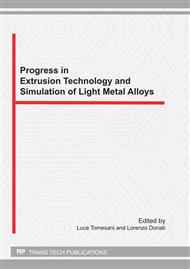p.1
p.11
p.19
p.27
p.35
p.43
p.51
p.59
Finite Element Modelling of the Charge Welds Evolution in a Porthole Die
Abstract:
Although the extrusion process is regarded as a continuous process, in practice billets are discretely loaded into the press. The joining of two consecutive billets is guaranteed by the high hydrostatic pressure of the process. Nevertheless, mechanical proprieties of the profile in the welded region are lower than those of the adjacent area thus leading to the discarding of the welded segment. Extension of the segment is mainly affected by the interaction of seam and charge welding phenomena and, nowadays, its prediction is still a tricky task involving rough empirical relations or labour intensive analyses. Aim of this work was to identify the starting and exhausting points of the charge welds evolution inside an industrial multi-profiles die, in order to determine the exact position and the minimal length to be scraped. The extrusion of four AA6060 hollow profiles through a multi-hole die were preliminary monitored in an industrial press by accurate recording of the process loads, temperatures and speeds during the process. The four profiles were sectioned starting from the ‘stop mark’ then grinded and etched in order to investigate the location and the dimension of the zone to be ridded. While the experimental activity is detailed elsewhere, this paper is focused on the finite element modelling of the process. The numerical simulation was performed by means of the Altair HyperXtrude code and predictions compared to experimental data with a particular focus on the computation of the charge evolution. It was found a good agreement both in terms of general trend and prediction of the exhausting points so thus proving the code to be a reliable tool for an accurate determination of the scraps.
Info:
Periodical:
Pages:
19-26
Citation:
Online since:
September 2011
Authors:
Keywords:
Price:
Сopyright:
© 2012 Trans Tech Publications Ltd. All Rights Reserved
Share:
Citation:


